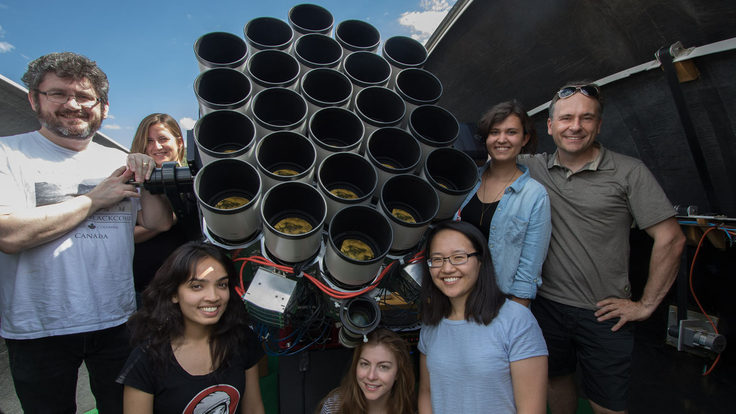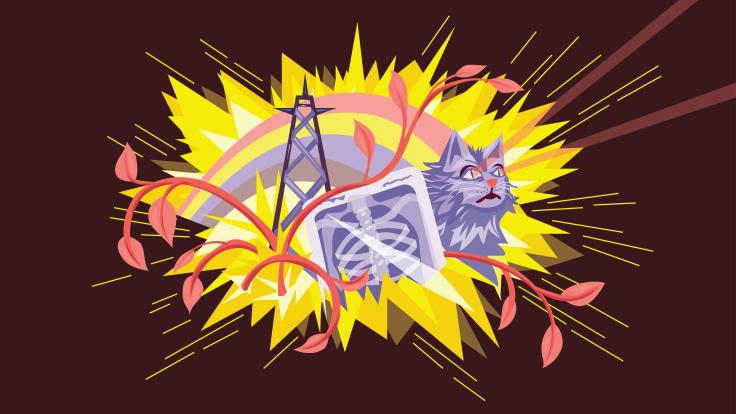
Rick Labahn, project engineer (left) and Ben Sayler, director of education and outreach at Sanford Lab, check out the almost-finished Davis Cavern, located about a mile underground in the former Homestake mine. Photo by Matt Kapust, Sanford Underground Laboratory
Construction of a 12,000-square-foot research campus a mile underground is nearing completion in the Black Hills of South Dakota, and scientists will begin to move the first physics experiments underground this spring.
“We’re on schedule for occupancy in March 2012, but it’s quite a little process,” said Project Engineer Rick Labahn, understating the complexity of his job.
Labahn is directing the outfitting of the Davis Campus, which comprises two large underground halls at the 4,850-foot level of the Sanford Underground Laboratory in the former Homestake gold mine. Early next spring researchers will begin installing two experiments there—both of them at the leading edge of 21st-century physics. The Large Underground Xenon experiment, which already is taking test run data in a building on the surface, aims to become the world’s most sensitive detector to look for a mysterious substance called dark matter. Thought to comprise 80 percent of all the matter in the universe, dark matter remains undetected so far. The second experiment, the Majorana Demonstrator, will search for one of the rarest forms of radioactive decays—neutrinoless double-beta decay. Majorana could help determine whether subatomic particles called neutrinos can act as their own anti-particles, a discovery that could help physicists better explain how the universe evolved.
The site of the Davis Campus already is a landmark in neutrino physics. It’s named for the late Ray Davis, a nuclear chemist who in the mid-1960s designed a pioneering experiment to detect neutrinos produced in the sun. Davis put his neutrino detector 4,850 feet underground to shield it from the noise of cosmic radiation, and his research earned him a share of the Nobel Prize for physics in 2002. Homestake closed in 2003, but in 2007 the South Dakota Science and Technology Authority began reopening the mine for a range of experiments that require shielding from cosmic radiation.
Sanford Lab technicians, many of them former Homestake miners, have enlarged the original Davis Cavern, which is now 60 feet long by 30 feet wide by 40 feet tall. The LUX experiment will be installed there. They’ve also excavated a new underground hall, the Transition Cavern—135 feet long by 50 feet wide by 17 feet tall—where the Majorana experiment will be installed.
The Transition Cavern will be equipped with showers for people and a “cart wash” for equipment. Everyone and everything entering the Davis Campus must be as free as possible of contaminants. Outside the clean area, a third cavern has been excavated for mechanical infrastructure such as air conditioning, an electrical substation and emergency generators.
The area of the Davis Campus is bigger than four tennis courts, and almost every square inch of that space is spoken for by the infrastructure and equipment needed to run LUX and Majorana. Most of that materiel is being lowered down Homestake’s Yates Shaft on two work decks, each of them 4 feet wide by 12-feet deep. When completed, the cargo will have included:
Items too big for the work decks—such as a batch plant for mixing concrete and 32-foot steel beams for construction of the LUX lab—are slung beneath the decks and lowered to the 4850 Level in a step-by-step process developed during decades of underground mining.

The Transition Cavern, 135 feet long by 50 feet wide, will host the Majorana experiment and will be equipped with showers for people and equipment to keep the research campus as free as possible of contaminants. Photo by Matt Kapust, Sanford Underground Laboratory
A local contractor, Ainsworth-Benning Construction of Spearfish, S.D., is outfitting the $8 million campus. This nine-month phase of the project began in July. By early December, all of the concrete floors had been poured, about half of the block walls had been built and installation of ductwork had begun. This month contractors will install the second-story steel deck for the LUX experiment and a 71,600-gallon stainless-steel water tank that will protect the LUX detector from background gamma radiation and stray neutrons.
“The progress has been extraordinary,” LUX physicist Rick Gaitskell of Brown University said during a recent inspection trip to the 4850 Level. The heart of the LUX detector is a titanium cryostat that will hold more than 770 pounds of liquid xenon, cooled to a minus 170 degrees F. Photomultiplier tubes and an electrical wire grid in the detector will register photons and electrons kicked out when dark-matter particles collide with xenon atoms. The LUX detector already has been assembled in a surface lab and filled with liquid xenon for a test run that will last several weeks.
“The whole thing is coming together very nicely,” said Gaitskell’s colleague, Case Western Reserve physicist Tom Shutt. “We’re learning the detector on the surface. When we fire it up next year, underground, it should be the world’s most sensitive dark matter detector.”
The Majorana team already is underground, electroforming the world’s purest copper in a temporary cleanroom on the 4850 Level, just over half a mile from the Transition Cavern.
“We’re pushing very hard so we can hit the ground running when we move into the Transition Cavern,” Majorana spokesperson Steve Elliott of Los Alamos National Laboratory said. The team has manufactured more than 20 percent of the 5,000 pounds of radiation-free copper that will shield the experiment and hold in place the enriched germanium crystals used to look for neutrinoless double-beta decay. “I was very impressed with how the outfitting is going,” Majorana Principal Investigator John Wilkerson of the University of North Carolina said after a visit to the 4850 Level. The Majorana Demonstrator will test detector technology in preparation for a larger, next-generation experiment.
South Dakota has committed nearly $130 million to the Sanford Underground Laboratory, including a $70 million donation from philanthropist T. Denny Sanford. Meanwhile, the Department of Energy is weighing how to use the Sanford Lab’s great depth for long-term projects, such as a proposed partnership with Fermilab to build the Long-Baseline Neutrino Experiment. The expanded DOE project, known as the Sanford Underground Research Facility, SURF, could provide research opportunities for decades.






